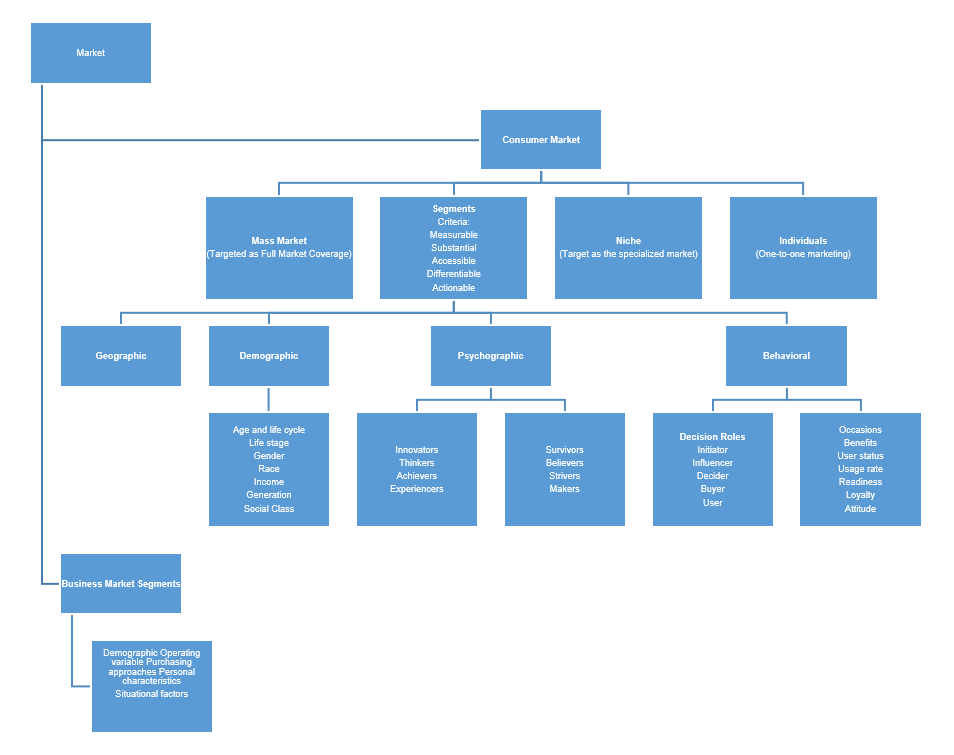The different levels of market segmentation
While developing effective marketing strategies and plans, managers refer to segmenting the market in order to determine the areas in which the product or services will be proposed. The overall levels of segmentation include the mass market, the segments, niches, and individuals. The managers choose whether to compete within the mass market, the certain segment, the specific niche, or be oriented to individuals. When segments are selected, the managers focus on their characteristics and differences in order to address the chosen category directly (Kotler and Keller 213). In their turn, the segments as groups of customers with specific needs and expectations in the market can be determined with the help of focusing on variables or differences of potential customers.
Dividing the market into segments
The process of dividing the market into segments includes the focus on variables or characteristics of customers. Traditionally, the managers divide the market into segments while referring to such variables as behavioral, geographic, psychographic, and demographic ones. The whole process of the segmentation includes several steps like the identification of the buyers’ profile with the focus on their interests and needs. At this stage, the managers select customers with references to their demographic characteristics such as age, gender, ethnicity, religion, family size, education, and income among others.
They also pay attention to the psychographic elements like personality traits, their specific lifestyles, and visions in order to create the complete profile of the ideal customer. In this context, the potential buyers can be divided into innovators, thinkers, achievers, experiencers or survivors, believers, strivers, and makers (Kotler and Keller 226). The next step is the focus on the behavioral segmentation. It is important for the managers to select the category of customers according to their attitude and actual responses to the product. The segmentation is realized according to the decision roles or behavioral variables (Kotler and Keller 227). Then, the managers select the specific market segment or several segments to start operations in them. The managers also rely on the geographic segmentation, and they determine which countries or cities they will serve or where the products can be purchased effectively.
The requirements for effective segmentation
The market segmentation can be discussed as effective when certain criteria or requirements are addressed. First, the managers need to focus on measurable markets. It means that the segment’s features such as the number of potential customers can be measured. Second, the segment should be substantial in terms of its size and potential advantages. It is profitable to serve large markets selected according to the careful segmentation process. The next requirement is the accessibility. It is important for the company to identify segments that can be easily served. In addition, segments need to be differentiable. It means that segments need to differ from each other in terms of the customers that are included in them. One more requirement is that the segment needs to be actionable (Kotler and Keller 232). The managers should have the opportunity to formulate and develop effective programs to address segments.
Business markets segmentation
Business markets are segmented like consumer markets, but there are also additional variables. As a result, the business markets are determined with the focus on demographic variables, numerous personal characteristics, operating variables, specific purchasing approaches, and definite situational factors that influence segments. Demographic variables include the segmentation according to the company’s size, industry specifics, and the company’s location. Operating variables refer to the customer technologies and capabilities. Purchasing approaches include all policies and rules associated with the process of purchasing the product or service. Situational factors include the order specifics and its urgency. Personal characteristics are important to determine the loyalty factor and attitudes (Kotler and Keller 230).
Choosing the most attractive target markets
Markets can be targeted as mass markets, segments, niches, and individuals. It is a challenging task for a company to identify the most attractive market to target, and this process should be based on the certain kind of analysis. It is necessary to measure the attractiveness of the market segment with references to its size, number of potential customers, and its accessibility. However, it is also necessary to correlate the attractiveness of the segment with the company’s specific goals and capacities. Thus, it is important to choose target markets in terms of their size, the potential for the development, profitability, and minimal risks. The correlation with the company’s objectives is a necessary condition because the market that is discussed as generally attractive can be inappropriate for the company because of available resources and set goals (Kotler and Keller 232). The company can choose the full market coverage while having enough resources; the specialization in several segments to address more consumers; the specialization in only one segment while having the limited resources and the narrowly targeted product; and the individual marketing when the number of potential customers is rather low.
Chart

Works Cited
Kotler, Philip, and Kevin Lane Keller. Marketing Management. New York: Prentice Hall, 2011. Print.